Brieef History
Originally founded by King U-Thong in 1350 within a bend of the Chao Phraya river, Ayutthaya was the capital of the Thai kingdom at its mightiest. Conquered and sacked by the Burmese in 1767, today only the ruins of its splendor remain. The modern city was founded a few kilometers further east.
Ayutthaya was originally known as "Ayothaya" which refers to the capital of King Rama (see Ramayana). When King Naresuan the Great defeated the Burmese, he changed the name of the city to "Aytthaya" meaning "the undefeatable city".
The Bowring Treaty (1855), signed by King Mogkhut between Siam and Britain, was the first of its kind and successfully opened up Siam to Western influence and trade.
The ruins of the old capital in the Ayutthaya historical park are now a UNESCO World Heritage Site. and have been so since December 1991.
Among Thai cities, Ayutthaya's English name is probably the least standardized - it is also known as Ayotaya, Ayothaya, Ayudhya, Ayutaya, Ayuthaya and Ayuttaya.
Climate
Ayutthaya, located in the central plains, is affected by three seasons:
Hot Season: March – May
Rainy season: June – October
Cool season: November - February
Culture
Ayutthaya, due to its history as a previous capital of Thailand, the former base of Thai Buddhism and home to tens of kings; it is soaked in original Thai-Thai culture.
Lifestyle
than one hour. Now with the
toll way and the divided
highway it is very convenient
to visit this ancient old capital
of Thailand.
By Car
From Bangkok, one can get to Phra Nakhon Si Ayutthaya by various routes:
Take Highway No.1 (Phahon Yothin) via Pratu Nam Phra In and turn into Highway No.32, then, turn left to Highway No.309 to Phra Nakhon Si Ayutthaya.
Take Highway No.304 (Chaeng Watthana) or Highway No.302 (Ngam Wong Wan), turn right into Highway No.306 (Tiwanon), cross Nonthaburi or Nuanchawi Bridge to Pathum Thani, continue on Highway No.3111 (Pathum Thani – Sam Khok – Sena) and turn right at Amphoe Sena into Highway No.3263 to Phra Nakhon Si Ayutthaya.
Take Highway No.306 (Ban
Take Expressway No.9 (Si Rat Expressway) via Nonthaburi – Pathum Thani and down to Highway No.1 via Bang Sai Royal Folk Arts and Crafts Centre, turn left into Highway No.3469 towa
By train
The cheapest and most
Please note, from experience, when you enquire about train services at the official information or ticketing counters, rates vary, perhaps due to the confusing variety of train services. But
In addition, a Bangkok – Phra Nakhon Si Ayutthaya train pulled by a steam locomotive is usually provided by the State Railway of Thailand on 3 special occasions every year. The first one is on 26 March which marks the establishment of the State Railway of T
Ayutthaya's train station is to the east of the central island. The easiest way to get to central Naresuan Road is to walk straight ahead from the station and take the cross-river ferry for 4 bah
By bus
Buses operate every 20 minutes or so from Bangkok's Northern Bus Terminal (Moh Chit*) directly to Ayutthaya. First class air-con buses charge 60 baht, while second class is 45 baht. Allow at least two hours for the trip since the buses stop rather frequently and there
To get to Northern Bus Terminal, take to Moh Chit LRT Station. Upon exiting gantry gates, cross the bridge on the right to go to bus-stop, and take bus service 3 or bus service 77. (air-con buses charge 12 baht, non air-con buses charge 7 baht.) Bus ride is about 10 - 15 minutes and the Northern Bus Terminal destination is the last stop for the bus services. However, buses do not stop in the Northern Bus Terminal, but at the bus stop across. Cross the bridge to get to the Bus Terminal.
Also you can take a mini
The buses are from 4:30AM–7.15PM. For more details, please call Tel. 0 2936 2852-66 or see the website [3] and Ayutthaya Bus Terminal, Tel. 0 3533 5304.
In Ayutthaya, the central BKS bus station is on the south side of Thanon Naresuan next to the Chao Phrom Market. songthaews to Bang Pa-In also leave from here. Some 1st-class buses to Bangkok, however, leave from the north side of the road some 500m to the west, on the other side of the khlong (canal); the queue for air-con buses is easy t
From Kanchanaburi, take a local bus from the main bus station to Suphanburi for 45 baht (2 hours), then another local bus to Ayutthaya for 40 baht (1.5 hours). A taxi from Kanchanaburi costs 2000-2500 baht (2 hours).
There is also a central bus station east of town serving northern destinations. It can be reached by songthaew - ask around to find the appropriate stop.
By minibus (Van)
Convenient minibus service (can get stuck in traffic, but makes no stops like regular buses) operates from the Victory Monument square in Bangkok. Take BTS Skytrain to the Victory Monument station, and go right on the elevated walkway - keep on it until you cross a large road, then descend - the buses are parked at the side side of the main traffic circle). The cost is usually ~70 baht, takes around 1 hour or 1 hour 20 min. It's quite convenient since you don't have to go to bus terminals (nearby Mochit) but the only problem is that the minibuses don't have much space to put big bags and have to wait until the car is fully filled.
Minibuses (Van) fr
By boat
Cruise boats run up the river from Bangkok, often stopping at Ko Kret and Bang Pa-In along the way. You'll need to book in advance as there are no scheduled services, just trips for tourists. It's a fairly lengthy trip (at least one whole day) and some of the
Travelling by boat to Phra Nakhon Si Ayutthaya is popular among foreigners since it does not only reveal the beauty as well as lifestyle of the people on both sides of the Chao Phraya River, but also reflects the life in history at the time of the Ayutthaya Kingdom when the Chao Phraya River served as a channel of transportation in trading with foreign countries.
Cruise to Ayutthaya
The luxurious cruise from Bangkok to the former capital of Ayutthaya is operated by River Sun Cruise
Where to Stay and Eat
| U-THONG INN | Executive Hotel & Conference Center. | |||
| | KRUNGSRI RIVER HOTEL | The luxurious nine-storied hotel. | ||
| | Baan Suan Guest House | Baan Suan means Garden House in Thai.. | ||
| | Chowpraya Hut | Thai cuisine evolved in the Central region of Ayutthaya. | ||
| | The Old Palace Resort | The Old Palace Resort and Spa. | ||
| | Puk Hai Exclusive House | Located on the lowland river plain surrounding. | ||
| | P.U. INN UBONPON | One of the best places to stay in Ayutthaya. | ||
| | Intarakorn Resort and Spa | The atmosphere of our hotel resort and Spa. | ||
| | BANN KUN PRA | The river side building locates the restaurant. | ||
| | Ayutthaya Garden Hut | Located in the quite village that still full of country living style. | ||
| | Intarakorn Guesthouse | Located in the city center of Ayutthaya. | ||
| | Ayothaya Hotel | The place are In central of Ayutthaya city. | ||
| | Ayothaya Riverside Hotel | Overlooks Pasak River and is surrounded. | ||
| | Ayutthaya Grand hotel | Near the center of the city. | ||
| | Ayutthaya Thanee hotel | Being located in a commercial area. |
Riding on Elephants

Elegant and soft elephant walk.
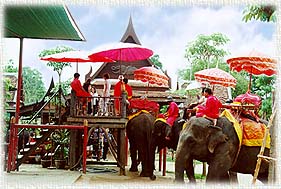
Platform for easy access to elephant.
The tourist attraction here is to ride on the elephant's
back and walk around part of the old capital. The
distance is not far because there are many tourists
waiting for their turns, and the owner does not want
elephants to be too tired. Experience this riding while
you are in Ayutthaya.

Friendly young elephants for picture taking
with tourists.

Feeding elephants from your own hands.
Temples of Ayuthiya
Wat Puthaisawan
This temple is located not far from the Portugese Village.
The entrance leads to the statue of King Naresuan the Great
and King Agatosarot where people come to play respect.
Inside the temple, three Buddha images are located.
According the the history during Ayutthaya period this
temple was famous for its sword fighters training.
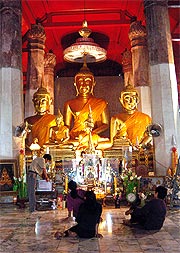
The Buddha Images.
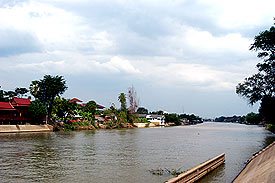
The river view in front of the temple.

Statue of the Three Kings.

The Temple and the Pagoda.
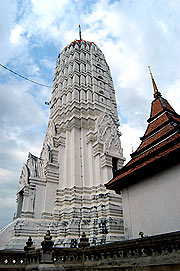
Wat Mahathat (วัดมหาธาตุ)
The construction of Wat Mahathat was begun during the reign of
King Borommarachathirat 1 in 1374 A.D. but it was completed
during the reign of King Ramesuan (1388-1396 A.D.). When King
Songtham (1680-1628 A.D.) was in power the main prang (Khmer-
style tower) collapsed. The restoration work on the prang was
probably completed in the reign of King Prasartthong (1630-
1655 A.D.). During the restoration the height of the prang was
considerably increased.
Wat Mahathat was restored once again during the reign of King
Borommakot (1732-1758 A.D.) when four porticos of the main prang
were added. In 1767 A.D. when Ayutthaya was sacked the wat
was burnt and has since then been in ruins.
Wat Mahathat was a royal monastery and has been the seat of
the Sangaraja, the head of the Buddhist monks of the Kamavasi
sect, since the time of the Mahathera Thammakanlayan, who was
a contemporary of King Borommarachathirat 1, who built the wat.
During the reign of King Rama VI in the Rattanakosin period,
about 1911 A.D., the main prang of the wat collapsed again and
looters seized the opportunity to dig for treasure. Only in 1956
A.D. did the Fine Arts Department undertake excavations around
the central area of the prang where the relics must have been
kept. The relics of the Buddha were found in the stupa within a
seven layer reliquary. Other antiquities were recovered as well,
including Buddha images, votive tables, covered boxes shaped
like fish and golden plaques in the form of animals. All these
objects are now at the Chao Sam Phraya National Museum.
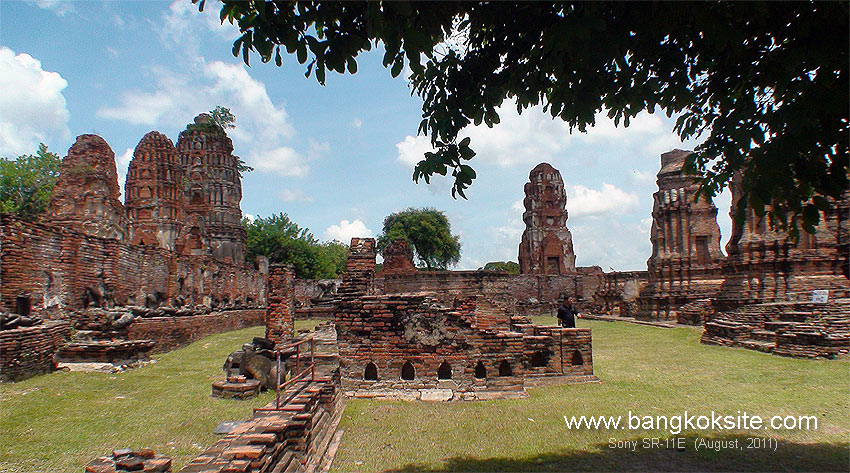


The Buddha Image
Wat Ratchburana (วัดราชบูรณะ)
In 1424 A.D. King Intharachathirat passed away. His two sons,
Chao Aye Phraya who reigned over Suphanburi, and Chao Yi
Phraya who reignned over Sanburi, met in battle as each desired
the throne. This took place at the approach to the Pa-Than bridge
and ended with the death of both sons. A third son, Chao Sam
Phraya came down from Phitsanulok and acceded to the throne
where upon he declared his intention to organize a funeral for
his father and his two brothers. Afterwards he ordered the building
of a wat, namely Wat Ratchaburana, at the site of the cremation
and at the place where his brothers fought and died. He has two
chedis created in which to keep their ashed.
In September of 1957 A.D. looters dug into a two-level crypt
inside the main prang (Khmer-type tower) and stole a great
quantity of material. Police arrested some of these looters. The
Fine Arts Department proceeded to excavate the site and found
Buddha images and many artifacts made of gold. Among these
were a large number of votive tablets made of gold and lead. In
1958 A.D. the Fine Arts Department built a stairway so that one
could go down into the crypt and look at the paintings which
were also found there. Since the Buddha images and votive
tablets discovered in the crypt were very numerous, the ministers
of the government approved giving some of them to people who
had contributed to the building of the Chao Sam Phraya National
Museum, much of the collection in which was found at Wat
Ratchaburana.
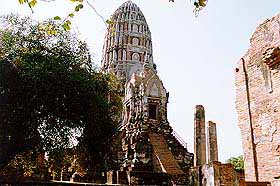
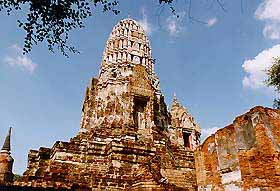
This temple is located in front of the royal palace of Ayutthaya.
According to the chronicle of the north, this was founded by
Phraya Thammikarat, a son of King Sainam Phung before the
Ayutthaya period. It was then called Wat Mukkharat, since
then the name was changed in honour of the founder.
Important monuments which may be found inside the temple
are : the chapel which used to enshrine a huge bronze Buddha
image (now on displayed at the Chao Sam Phraya National
Museum); a bell-shaped chedi; an ordination hall; and a hall
housing a reclining Buddha image. All these monuments are
of the Ayutthaya style of the 14th to the 17th century.
The temple has been renovated.
(New pictures taken on September 21, 2002)
The temple has been renovated.
(New pictures taken on September 21, 2002).

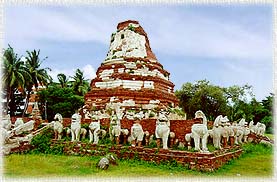
Picture shot on June 24, 2001.

New picture shot on August 21, 2004
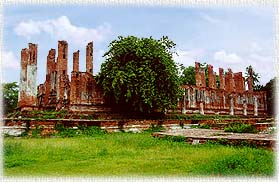
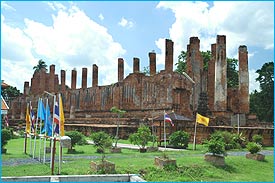
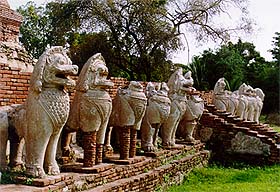
Wat Phra Sri Sanphet (วัดพระศรีสรรเพชญ์)
The royal palace was located here from the establishment of
Ayutthaya in the reign of King Ramathibodi 1 (1350 A.D.) to the reign
of King Sam Phraya (1448 A.D.). Later King Borommatrailokanat
ordered a wat to be built on this site in 1448 A.D. to be used as a
monastic area.
After the reign of King Borommatrailokanat, his son King Ramathibodi II,
ordered the construction for two chedis, one of which was kept the
ashes of his father and the other those of his brother, King Borom-
marachathirat III. Another chedi was built by order of King Borom-
rachanophuttangkun. It was similarly used to house royal remains
those of King Ramathibodi II.
In 1499, a principal viharn was built. The following year, in 1500 A.D.,
King Ramathibodi II commanded the casting of a standing Buddha
image 16 meters high and covered with gold. This image, Phra
Buddha Chao Si Sanphet was the main object of veneration in the
royal viranra (hall of worship). After that time the ashes of members
of the royal family other than the kings were placed in small chedis
constructed at the site.
Wat Phra Si Sanphet was the royal chapel and as such did not
have a Sangavasa (no monks dwelt there). It was used for royal
ceremonies.
When Ayutthaya was sacked in 1767 A.D. the gold which covered
was taken by the invaders. During his reign King Rama I (1782 -
1809 A.D.) of the Ratanakosin Period ordered the transfer of the
inner core of Phra Buddha Chao Si Sanphet from Ayutthaya to Wat
Phra Chetuphon in Bangkok, and had it placed in a chedi specially
built for the purpose. Another Buddha image of importance called
Phralokanat was also brought to this wat at about the same time.
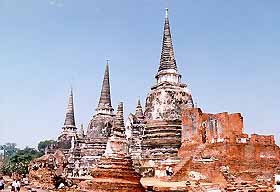

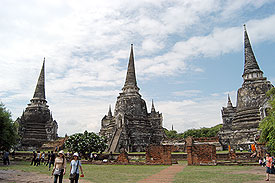
Click for a large picture
Elephant Kraal Pavillion (Phaniat เพนียด คล้องช้าง)
In the old time wild elephants were searched and chased
into the "paniat". The Pavillion, utilized as the royal seat to
witness the elephant round up, is located 4 kms. from the city
along Highway No.309.
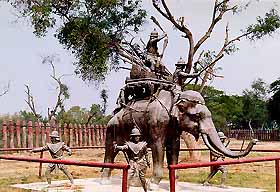
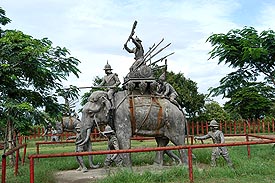
Model of elephant ready for fighting with the enemy.
Paniat
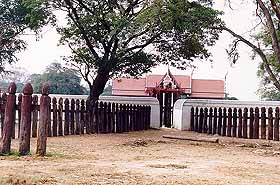

The pavillion or Sala where people
observe the ceremony at Paniat.
Monument of King Naresuan the Great
and Chedi Phukhao Tong

Chedi Phukhao Tong viewed from Wat.
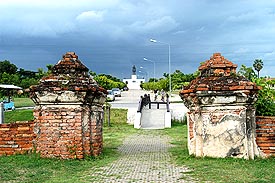
The Entrance to Chedi Phukhao Tong (Looking out)

Monument of King Naresuan the Great
Chedi Phukhao Tong (13/8/2001)
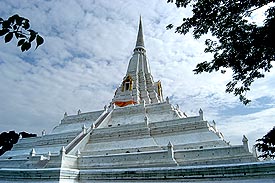
Click for large pictur
Wat Na Phrameru Rachikaram
(วัดหน้าพระเมรุ ราชิการาม)
Oung-In in the reign of King Ramathibodi II, the tenth king of Ayutthaya,
ordered the construction of this temple in 1499 A.D.
The temple was the place where the king of Thailand and the king of
Burma agreed on the peace issue and as a witness they had brought
the Buddha image, the holy book and monks there.
After that in 1760 A.D. the king of Burma had invaded Thailand and
used this temple to place canons and fired them into the Royal
Palace area. One of this shells hit a part of royal palace named
Suriya Ammarin and destroyed it. During that war King Along Phya
fired a canons by himself and one of the canons bursted out and
he was seriously injured. He had to withdraw the troops and intended
to go back to Burma, but he died at Tak border.
Thus Wat Na Phrameru Rachikaram was the only temple not destroyed
during the war with the Burmese.
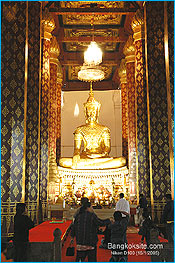 | The Buddha image at Wat Na Phrameru as shot lately on January 15, 2005. |

Click for a new large picture (Aug.24, 2004)

The Buddha Image
Wat Chaiwatthanaram (วัดไชยวัฒนาราม)
Wat Chaiwatthanaram, one of the most imposing ancient Buddhist
monasteries, was established by the command of King Prasatthong
in 1630 A.D. It is believed that the wat is located on the site of
his former home. The reason for building this monastery was to
make merit for his mother. Prince Damrong Rachanuphap noted
that its architecture was similar to that of Angkor Wat and inferred
that the wat might have been built to commemorate the king's
victory over Cambodia.
This wat consists of a main prang (Khmer-type tower) and four
lesser prangs, all created on the same base ans surrounded by
eight lesser prangs and a gallery.
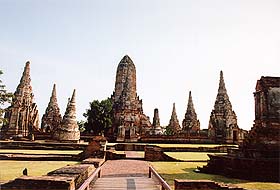
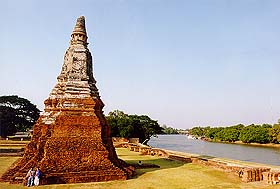
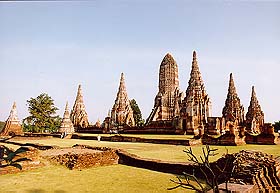
Phra Chedi Sri Suriyothai (พระเจดีย์ ศรีสุริโยทัย)
Phra Chedi Sisuriyothai is the memorial to Somdet Phra Sisuriyothai,
the Thai heroine in the Ayutthaya period. She was the queen of
Somdet Phra Mahajakrapat, the king of Ayutthaya which reigned
when he was 36.
After King Somdet Phra Mahajakrapat reigned in 1548 A.D. for 7
months, Phra Chao Tabengchaveti, the King of Burma, moved his
troops to beat Ayutthaya to revenge for the former unsuccessful
beat of Chiengkran town in the reign of King Chairajathirat.
In the first battle, King Somdet Phra Mahajakrapat would lead his
troops with his two sons, Prince Phra Ramesuan and Prince Phra
Mahintrathirat on elephants, but queen Somdet Phra Sisuriyothai
was concerned for her husband then she disguised herself as a
man in a fighting form and accompanied with them.
When the Ayutthaya's troops met the front Burmese troops, which
was led by Phra Chao Phrae, King Somdet Phra Mahajakrapat rode
his elephant to fight against Phra Chao Phrae, but his elephant was
in collapse so Phra Chao Phrae raised his scythe to cut King
Somdet Phra Mahajakrapat, queen Somdet Phra Sisuriyothai nearby
had seen the event, she decided to save her husband by riding her
elephant to intervene the fighting. She was killed by the scythe of
Phra Chao Phrae on her elephant back. Then their two sons helped
them and moved the corpse back.
With her devotion, King Somdet Phra Mahajakrapat constructed a
chedi, called Phra Chedi Sisuriyothai at Wat Suanluang Sobswan,
Hualaem District.
Chedi Sri Suriyothai (13/8/2001)
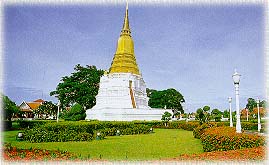
Chedi Sisuriyotha
Phra Chedi Sri Suriyothai (พระเจดีย์ ศรีสุริโยทัย)
Phra Chedi Sisuriyothai is the memorial to Somdet Phra Sisuriyothai,
the Thai heroine in the Ayutthaya period. She was the queen of
Somdet Phra Mahajakrapat, the king of Ayutthaya which reigned
when he was 36.
After King Somdet Phra Mahajakrapat reigned in 1548 A.D. for 7
months, Phra Chao Tabengchaveti, the King of Burma, moved his
troops to beat Ayutthaya to revenge for the former unsuccessful
beat of Chiengkran town in the reign of King Chairajathirat.
In the first battle, King Somdet Phra Mahajakrapat would lead his
troops with his two sons, Prince Phra Ramesuan and Prince Phra
Mahintrathirat on elephants, but queen Somdet Phra Sisuriyothai
was concerned for her husband then she disguised herself as a
man in a fighting form and accompanied with them.
When the Ayutthaya's troops met the front Burmese troops, which
was led by Phra Chao Phrae, King Somdet Phra Mahajakrapat rode
his elephant to fight against Phra Chao Phrae, but his elephant was
in collapse so Phra Chao Phrae raised his scythe to cut King
Somdet Phra Mahajakrapat, queen Somdet Phra Sisuriyothai nearby
had seen the event, she decided to save her husband by riding her
elephant to intervene the fighting. She was killed by the scythe of
Phra Chao Phrae on her elephant back. Then their two sons helped
them and moved the corpse back.
With her devotion, King Somdet Phra Mahajakrapat constructed a
chedi, called Phra Chedi Sisuriyothai at Wat Suanluang Sobswan,
Hualaem District.
Chedi Sri Suriyothai (13/8/2001)

Chedi Sisuriyothai
Phom Petch (ป้อมเพชร)
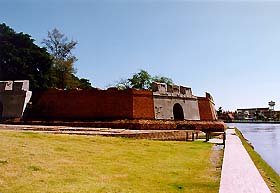
Pom Petch Fort
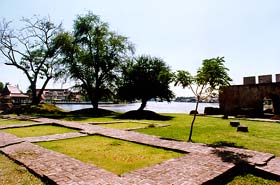
Scenic point at Pom Petch.

This fortress is at the location where three rivers meet.These rivers
are : Chao Phraya River, Pa Sak River, and Lopburi River.
In the Ayutthaya period there were probably 29 forts built. The
Pom Petch fort is the remaining one that was restored. On the
left and at the opposite side of the river is Wat Panan Choeng.
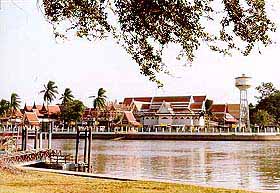
Wat Panan Choeng
Wat Suwandararam was built in the end of Ayutthaya |
| Wat Suwandararam |
|
  |
| |
|
Memorial Site of the Old Japanese Settlement in Ayutthaya Ayutthaya was the capital of the Kingdom of Thailand for 417 years from B.E.1893 (A.D.1350) to B.E.2310 (A.D.1767). During this period, in the second half of the 16th Century, foreigners began to come to the Kingdom and gradually in number. These foreigners were traders, missioneries, and some were engaged as volunteer guards of the King. Japanese trade aboard was also boosted when the Japanese Authorities granted official permission to travel for trading purposes by issuing the "Shuin" (Red Seal). Along with the official ships bearing the seal, unauthorized ships also sailed to South East Asia with many Japanese. Among the travellers were those who came to Ayutthaya. The King granted permission to the Japanese, as well as other nationalities, to settle. At that time there were 800 to 3,000 Japanese reported to be living in Ayutthaya. |
Wat Yai Chai Mongkol (วัดใหญ่ชัยมงคล)
| Wat Yai Chai Mongkol is situated to the southeast and opposite to Ayutthaya city. A large Chedi of this Wat can be seen from a far distance. This monastery was built by King U-Thong in 1357 A.D. for the use of the monks who had returned from Ceylon after studying under Phra Vanarat Maha Thera. |
People come to play respect and many tourists are seen
here especially during weekends.
Wat Panan Choeng (วัดพนัญเชิง)
Wat Panan Choeng is an old monastery housing Thailand's
largest ancient Buddha image, known as "Luang Po To".
A historical cronicle states that this gilded stucco image was
built in A.D.1344, some 26 years before the establishment
of Ayutthaya as the capital of the Thai Kingdom in A.D.1350.


Viharn Phra Mongkolbophit

The Buddha Images.

The Buddha Images.

The Reclining Buddha image and its Vihara were
probably built in the reign of King Naresuan. It was
particularly used for worship and meditation. The
present image was restored in A.D.1965.

The three stately Chedi of Wat Phra Sri Sanphet,
a royal temple built in 1491 that honors
three 15th-century kings.

River Scenery
An attractive trip when you are in Ayutthaya is
to take a boat ride and have fun while enjoying
lunch or dinner on the "Rice Boat", but modernized
with facilities, e.g. TV and Karaoke.
The once "Rice Boat" is now built as a restaurant
travelling along the river around Ayutthaya and
Bang Pa-In for tourists.
The trip by boat around Ayutthaya will give
impressive views of temples and lifestyle of the
local people.

The "Long Tail" boat.

During the end of the rainy season the
water level is high.











No comments:
Post a Comment